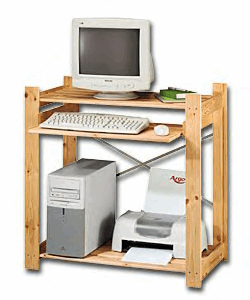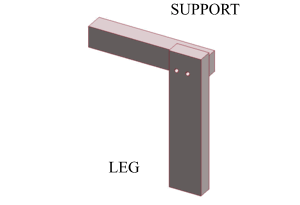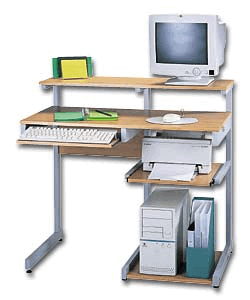
Revision - Resistant Materials 2003.
| The theme for your exam is Computer Workstations. You have already
received the pre-release material from the exam board which identifies
the areas to focus on for your revision. These are outlined below:
Construction techniques - How the desk could be assembled
. The vast majority of questions on your exam paper will be to do with this theme; however, there will also be some general Design and Technology questions which do not relate to the theme. Following are some questions you could get asked. Work through these questions as part of your revision. Questions you cannot answer, find out the answers to! 1.Below is a picture of a wooden computer desk. |
|
 |
|
| a)The desk is made from pine. Give 2 reasons why this material has been
chosen. b)Name a suitable hardwood the desk could be made from instead. c)The desk is supplied without a finish. What does this mean? d)Give 2 reasons why a finish might be needed on the desk. e)Name 2 suitable finishes that could be applied to the desk. f)The desk is sold as a ‘flat pack’. What does this mean? g)What are the advantages of flat pack furniture to the following: The manufacturer - The retailer - The consumer - h)The desk uses ‘KD fittings’ for its assembly by the consumer. What is a ‘KD fitting’? |
|
| 2.Below is a picture of part of a computer workstation. It shows a support for the desk top where it will join to a leg using 2 screws. The manufacturer is going to make the workstation in batches of 500. | |
 |
|
| a)Give 2 reasons why the manufacturer would use a jig to mark out and
drill the screw holes. b)Using notes and sketches, design a jig which the manufacturer could use to mark out and drill the holes. |
|
3.What is meant by the following terms:
|
|
| 4.List 5 pieces of anthropometric data a designer would use when designing a computer workstation. | |
| 5.Below is a picture of a different computer workstation. | |
 |
|
a)Name a suitable metal for making the frame and also give a reason.
|
|
6.Explain how a manufacturer of a wooden computer workstation can make the product environmentally friendly in the following areas:
|
|
|
7.Explain what this symbol means. |
|
 |
|
8.A manufacturer is going to add feet to the computer workstations it sells. These feet are going to be made on a CNC lathe.
|
|
| 9.Safety in the workshop is very important. List 6 safety points that a manufacturer should consider to ensure that it provides a safe environment for its workers. | |
| 10.In the space below, produce 2 designs for a computer workstation that will hold a PC, monitor, keyboard, mouse and printer. The design should include storage for 10 CD ROMs. Security should also be considered. The second design should be modified so that a wheelchair user can use the workstation with ease. | |

